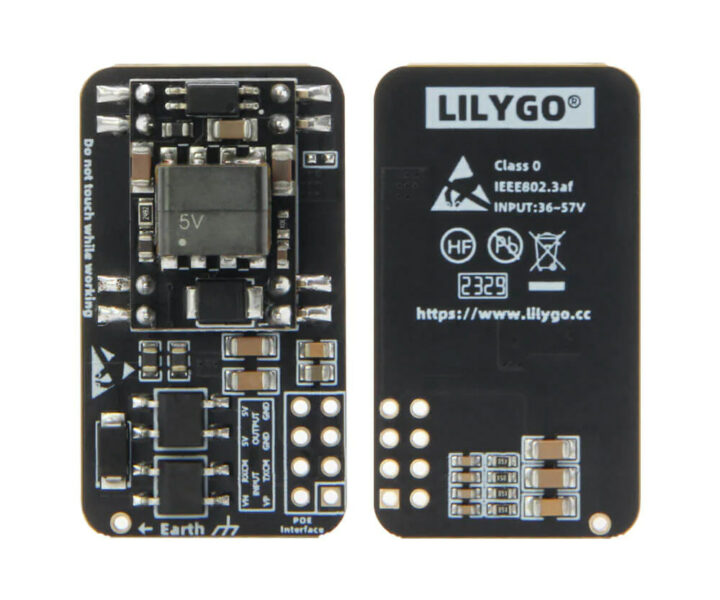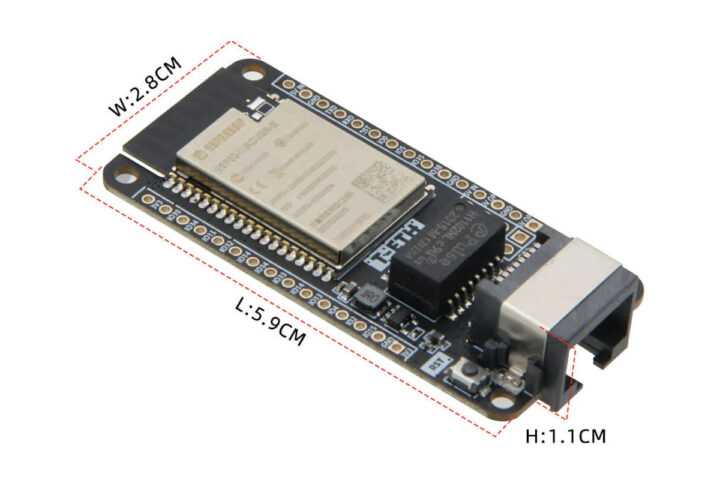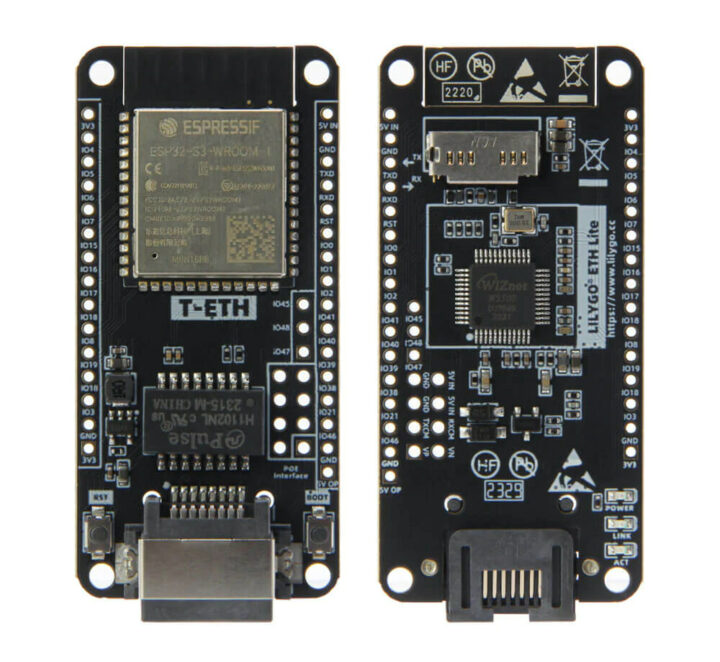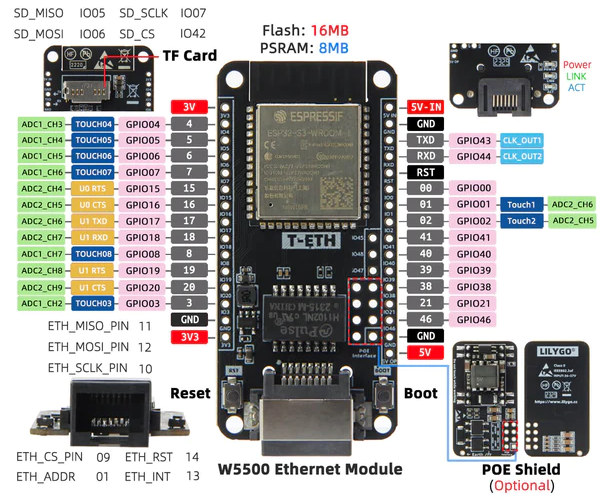LILYGO T-ETH-Lite ESP32-S3 is a new ESP32-S3 WiFi and Bluetooth development board with a low-profile Ethernet RJ45 connector using a WIZnet W5500 Ethernet controller, supporting PoE with an extra shield, and also equipped with a microSD card socket and expansion I/Os.
ESP32-based development boards with Ethernet have been around for years including LILYGO’s own “TTGO T-Lite W5500“, but so far we haven’t many based on the more recent ESP32-S3 microcontroller except for the SB Components’ ESPi board that we covered last April. But LILYGO T-ETH-Lite ESP32-S3 adds another cost-effective board with Ethernet.
LILYGO T-ETH-Lite ESP32-S3 specifications:
- Wireless module ESP32-S3-WROOM-1
- MCU – ESP32-S3 dual-core LX7 microprocessor @ up to 240 MHz with Vector extension for machine learning
- Memory – 8MB PSRAM
- Storage – 16MB SPI flash
- Connectivity – WiFi 4 and Bluetooth 5 with LE/Mesh
- PCB antenna
- Storage – MicroSD card slot
- Connectivity
- 802.11 b/g/n WiFi 4 up to 150 Mbps and Bluetooth 5 via ESP32-S3 SoC
- 10/100M Ethernet via SPI Ethernet board based on WIZnet W5500, optional PoE
- I/Os – 2x 15-pin headers with up to 23x GPIOs, 2x UART, 14x ADC, touch interface, Reset, 5V, 3.3V, GND
- Misc
- Boot & Reset button
- Power, Link, and Act LEDs
- Power Supply
- 5V via “5V-IN” pin
- 36 to 57V via optional PoE shield
- Dimensions – 59 x 28 x 11 mm
LILYGO provides a range of Arduino samples for their T-ETH boards based on ESP32/ESP32-S3 such as web server, OTA firmware updates over Ethernet, MQTT server, SPI and One-wire code, and so on. There’s also a code sample for a camera module designed for the T-ETH Lite ESP32-S3 board, but I’m unable to find that camera module for now. You’ll find the code samples, firmware, and schematics on GitHub. If you have some issues when using the board, you can ask for support in the community forum.

LILYGO is selling the T-ETH-Lite ESP32-S3 board on Aliexpress for $13.98 and a kit with the PoE shield for $25.98. Both are available via the same link along with the earlier ESP32-based board and PoE kit. The camera module is probably coming in the next few weeks.

Jean-Luc started CNX Software in 2010 as a part-time endeavor, before quitting his job as a software engineering manager, and starting to write daily news, and reviews full time later in 2011.
Support CNX Software! Donate via cryptocurrencies, become a Patron on Patreon, or purchase goods on Amazon or Aliexpress. We also use affiliate links in articles to earn commissions if you make a purchase after clicking on those links.








Unless I’m mistaken, it should be possible to run linux on such a board. Let’s wait and see what applications people invent with it 🙂
Does it have a proper MMU or is this more of a uC linux?
From what I understood, it’s between the two, i.e. no protection but you can mmap. There’s a thread here about this, and in it there are links to demo videos, and howtos: https://esp32.com/viewtopic.php?t=33675
No real talk about how they do the memory mapping work. But, since the ESP32 does some funny mapping to allow code and data access from on chip SRAM which is backed by SPI NOR and PSRAM, I wonder if they’re cleverly abusing that logic to perform that magic. Is so, that’s very clever.
I’m sorry if you didn’t find the info from there, I stumbled upon it maybe by chance. Whan I’d read is that their simplified MMU doesn’t support R/W protection but that it would at least support mapped/unmapped. I don’t know how they’re proceeding though.
That’s pretty much what I was assuming they could do from what they do just to do XIP, etc. with SPI NOR and PSRAM, so that makes sense. If you ever happen by that article in the future, please poke me and let me know, bucause I’d love to know the details. Thanks!
From what I see esphome lacks support for the W5500 Ethernet – so for now no use case for this board
ESPhome lack support of SD cards.
Hello. I can’t see any usb connection. So how one is able to program the board ?
Thank you
Do you see the TXD/RXD headers on the upper right of the top of the board? You can connect to them when pressing the boot button and resetting the board. Conveniently, there’s an RST signal right there if you wish to automate some of this.
Once you have it initially programmed you can always do OTA updates.
Espressif: *makes an ESP32 with MAC*
Lillygo: *uses a different device and adds a poor ethernet chip*
Not sure why you call the RTL8201 PHY “poor” . This module is rock solid and uses internal MAC, Try a ping flood.